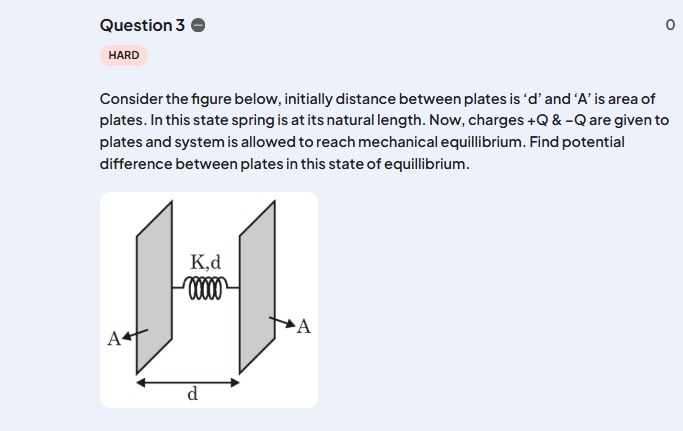Question
Question: Consider the figure below, initially distance between plates is 'd' and 'A' is area of plates. In th...
Consider the figure below, initially distance between plates is 'd' and 'A' is area of plates. In this state spring is at its natural length. Now, charges +Q & -Q are given to plates and system is allowed to reach mechanical equillibrium. Find potential difference between plates in this state of equillibrium.

V=ϵ0AQd−2Kϵ02A2Q3
Solution
-
Forces at Equilibrium: In the equilibrium state, the attractive electrostatic force between the charged plates must be balanced by the repulsive force exerted by the compressed spring.
- The electrostatic force between two parallel plates with charge Q and area A separated by a distance d′ is Fe=2ϵ0AQ2. This force is attractive.
- Initially, the distance between the plates is d, and the spring is at its natural length. When the plates move closer to d′, the spring is compressed by (d−d′). The spring force is Fs=K(d−d′), which is repulsive.
- At equilibrium, Fe=Fs, so 2ϵ0AQ2=K(d−d′).
-
Equilibrium Separation: From the equilibrium equation, we can find the new separation d′: d−d′=2Kϵ0AQ2 d′=d−2Kϵ0AQ2
-
Potential Difference: The potential difference V between the plates of a parallel plate capacitor is given by V=CQ, where C=d′ϵ0A is the capacitance at separation d′. Therefore, V=(ϵ0A/d′)Q=ϵ0AQd′.
-
Substitute Equilibrium Separation: Substitute the expression for d′ into the equation for V: V=ϵ0AQ(d−2Kϵ0AQ2) V=ϵ0AQd−2Kϵ02A2Q3
